|
I think I've probably covered enough movies by maverick filmmaker Sam Fuller now to be unable to provide an introduction that isn't just a rerun of things I've already said. If you want to know why I and so many others hold Fuller's work in such high regard, check out those reviews, which are listed at the bottom on the column on the right. In a couple of them you'll also find my fond recollections of the time I went to London to see Fuller interviewed on stage at the National Film Theatre to mark the release of The Big Red One. A point I make more than once about this event, and which continues to surprise me to this day, was how few of us there were in in attendance at what a couple of years later would have had standing room only, which gives you an idea how late it was in Fuller's long career that the now widespread appreciation of his greatness as a filmmaker and his influence on the next generation of directors came.
When we celebrate his films, it's easy to forget that he worked for some years as a writer before making his mark as a director and producer of his own scripts, and it's that aspect of his work that is the prime focus of Sam Fuller at Columbia 1937-1961, recently released on Blu-ray as a 4-disc box set by Indicator. Of the seven films here, only two were written, produced and directed by Fuller, the others being based on his writings either as scripts or, in one case, a prize-winning novel.
While some purchasers of this set – a small minority, surely – may feel short-changed by a Sam Fuller box set that only includes two features that he directed, for the rest of us this offers a welcome chance to chart Fuller's development as a writer and emergence as a distinctive voice, and to observe just how things changed when he was able to take complete control of his material. With this in mind, I'd heartily recommend watching the films in chronological order and not making a beeline for the ones directed by Fuller. Yes, they're without question the best films in the set, but you'll get even more from them if you slowly build up to them, as the quality steadily builds and then peaks with this extraordinary double-bill. And if you're planning on putting aside a week of free evenings to watch the films themselves, I'd set aside another if you're planning to watch the special features as well (and you really should).
I'll save any further gushing for the final summary and focus for now on the films themselves. I was initially determined to make my coverage of each short and to the point, but as I progressed this proved an increasingly impossible pledge to keep. Hell, this is Sam Fuller, after all...
Subtitled "...Once a Hero...", the 1937 It Happened in Hollywood, which Fuller co-wrote in what was only his second screenwriting credit, opens in calculatedly cornball fashion, then explodes into a tornado of breathless storytelling, only to flirt again with cornball on the way to a fascinatingly offbeat climax, then conclude in a manner so preposterous that could be used to teach a class on deus ex machina.
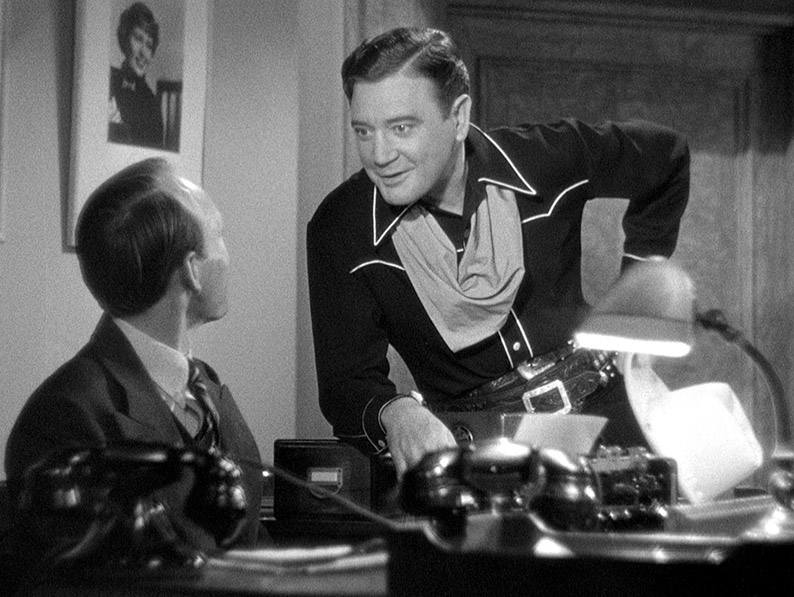
The year is 1928 and Tim Bart (Richard Dix) is a hugely successful star of Hollywood westerns. As the film opens, he's visiting a group of his youngest fans at a home for orphaned children and makes a special promise to a sick young boy who calls himself Billy the Kid (his name's Billy and he is a kid, so he's technically correct). Just seconds later, Tim is on the road again with his manager and a more down-to-earth side of his personality emerges, one that knows he needs to make more money to pay off the final instalments on his ranch. Then the news comes in that the first talking picture has been a runaway success, and Tim and his favourite co-star and love interest Gloria Gay (Fay Wray) are called back to the studio for a new screen test to see how they cope with having to deliver scripted dialogue. It turns out that Gloria's a natural, but Tim is as wooden as a hitching post, despite surprisingly non-condescending advice offered by an on-set English elocution coach. Thus, in the space of a few short minutes of screen time, Gloria's movie career looks set to soar while Tim's is effectively over, news he responds so calmly and pragmatically that I began to think that he may be the most level-headed actor who ever lived. Even when he loses his ranch to foreclosure, Tim remains unflustered and simply gets on with his life. Indeed, so honourable is our Tim that when offered the chance to play a gangster in Gloria's latest film, he initially resists for fear of how being cast as a bad guy will be received by his young fans, and when a script change has his character shoot a policeman, he walks from the project without a second thought.
There are some interesting tonal shifts during It Happened in Hollywood. The opening scene at the children's hospital, for instance, is almost wincingly mawkish, and as the smiling Tim pins a Special Sheriff badge on the doe-eyed Billy's pyjamas, I began to wonder how long it would be before I lost my lunch. Yet just minutes later the plot is being propelled along by the sort of dizzying montages that have long-since fallen out of filmmaking favour, but through which filmmakers were able to compress something like twenty minutes of narrative development into a few breathless seconds. The scene in which a film crew prepares to shoot the Tim and Gloria's screen test, meanwhile, is both lively and entertaining, and even has a whiff of documentary realism to it.
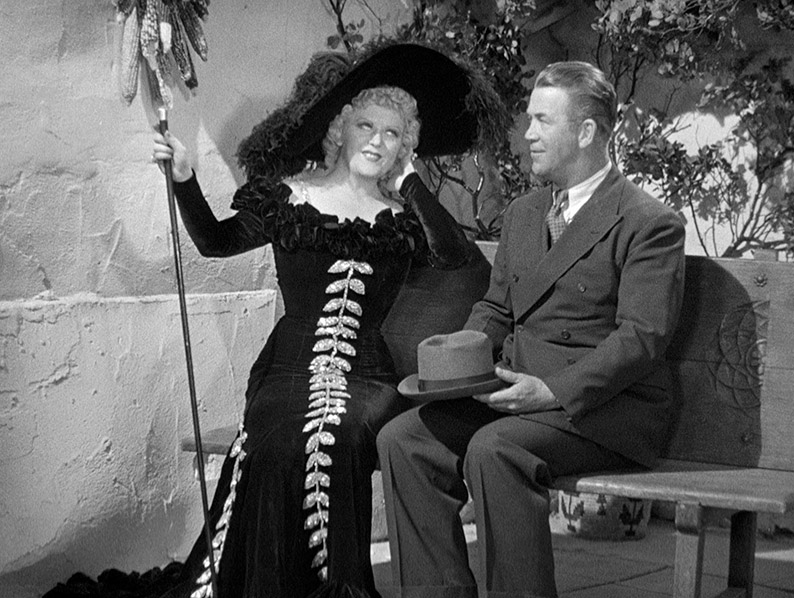
There aren't many twists to a story that is light on substance but gets by on charm, particularly once Billy the Kid makes a reappearance. But it's his arrival and heartfelt pleading that gives rise to a climax quite unlike any I can readily recall, as Bart throws a party for Billy to meet the stars, then recruits what looks like every celebrity impersonator and stand-in in Hollywood, many of whom bear a striking resemblance to the stars they are impersonating. None of which prepares you for what happens next, and while the film's vintage ensures that we know from an early stage that something will eventually happen to restore Tim's good fortune, you'd need to be a fortune teller of some skill to predict this most unlikely turn of events.
It's perhaps no surprise that there's little here that has what I'd think of as an obvious Sam Fuller stamp on it – this was only his second screen credit and was one he shared with two other writers. Yet while light on plot, It Happened in Hollywood a consistently engaging work with a briskly paced first half, likeable performances and an entertainingly daffy climax, and intermittently Harry Lachman directs with a confidence and drive that makes me wonder why he rarely landed the sort of prestigious projects he clearly had the filmmaking chops to take on.
American Jim Kelley is a pilot for a French airline, but just before he is due to take off on one of his scheduled flights, he receives a telegram informing him that his Legionnaire brother Robert has passed away. He promptly walks away from his job and signs up for the French Foreign Legion, specifically requesting that he be allowed to join a company led by Captain Savatt, whose cruel and unfeeling approach to discipline resulted directly in his brother's death. He gets his wish, and after a long and arduous march through the desert, he finds himself at Fort Agadez and under Savatt's command, and doesn't have to wait long to witness and experience the sort of treatment that led to his brother's untimely fate. And Savatt really is a bit of a monster, the sort who works a man to death and then dismisses his comrades and carries on with his day as if nothing untoward has happened. When Jim stands up to Savatt after a man dies in similar circumstances to Robert, he lands himself a spell in solitary confinement, and by the time he emerges the men are talking mutiny and proposing the still rebellious Jim as its leader.
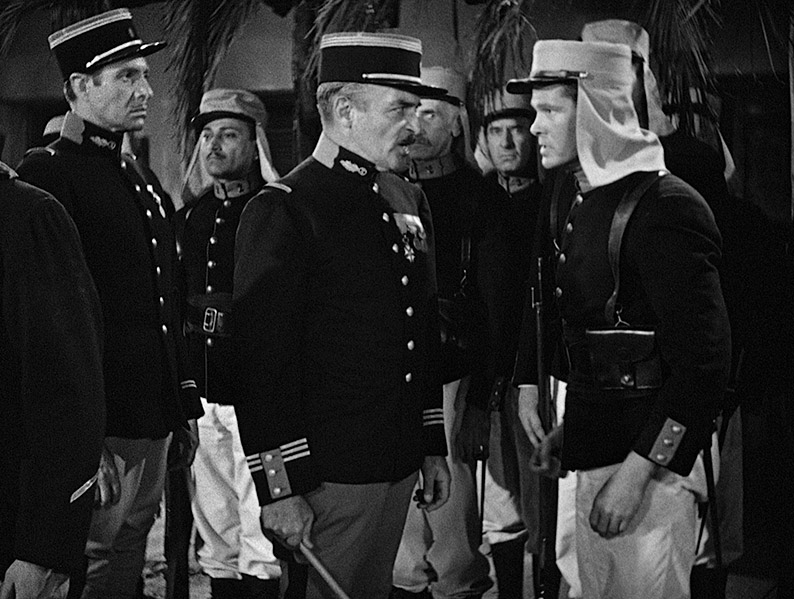
Beau Geste meets Mutiny on the Bounty in a film based on an original story by Fuller, whose ironic ending has been so diluted in translation that the irony in question has been all but erased. The borrowings are blatant (Savatt is Captain Bligh, Jim is Fletcher Christian) and are seriously watered down from the source material to squeeze the whole story into an hour of screen time, which does at least keep things moving at a busy pace.
Things take a slightly daffy turn when Jim's fiancée Carla – also a pilot – crash-lands her plane near to the fort to provide some gender balance to the drama, and to highlight the increasing post-mutiny discord by becoming the object of one man's drunken lust when supplies begin dwindling. Slightly more problematic is the character of Gungadin (oh yes), a black American legionnaire whom Jim quickly befriends in a manner that initially feels progressive for an American film made in 1938, but who still scurries around with cries of, "Yes sir, boss!" and in the post-mutiny fort effectively becomes Jim's manservant. He even does that embarrassing "Oh shucks" grin and head roll when Jim and Carla get together for a comforting snog.
It's an entertaining enough yarn, but an unoriginal one that pushes enough of the right narrative buttons to ensure a degree of engagement but does play a little too much like a quickly-made attempt to cash in on a road-tested formula. Paul Kelly makes for an inoffensive flawed hero but is generally outshone by C. Henry Gordon's uncompromising nastiness as Captain Savatt. For horror fans, however, the real interest lies in the supporting cast, with a legionnaire known as ‘The Jackal' played by cult actor Dwight Frye.
When John Cleveland Carter (Minor Watson), the publisher of a successful New York newspaper, is accused in a published editorial of hypocrisy and distorting the truth by his former friend and small-town newspaper editor, Ulysses Bradford (Guy Kibbee), he surprisingly admits the charges levelled against him. Indeed, so struck is he by Ulysses' words that he decides to admit his guilt to the distinguished guests at a high-profile business dinner that he is hosting, then identify the guilty parties and reverse the direction the paper has taken. Before he can name names, however, he is shot, and on his deathbed makes a new will in which he requests that Ulysses Bradford take over his role and reshape the paper. Initially reluctant, Ulysses is goaded into accepting the position by Carter's loyal personal assistant, Edwina (Gloria Dickson), but his attempts to ensure that the paper take a more balanced view of all stories from that point on meet with forceful resistance from amoral paper bigwig Howard Rankin (Otto Kruger) and decent but story-hungry editor-in-chief, Griff Thompson (Lee Tracy).
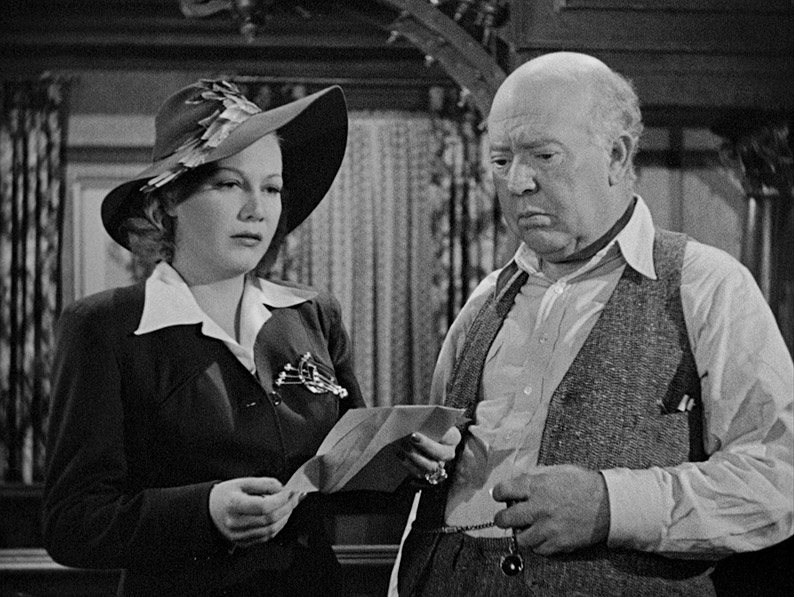
There aren't too many reviews out there for the provocatively titled Power of the Press, and most of those I've read tend to dismiss the film as a crudely propagandist and patriotic flag-waver designed from the ground up to make a case for America's involvement in the war effort. And yes, there is an element of this that's impossible to ignore, but having approached the film with these criticisms in mind, I was struck by how greatly this aspect had been exaggerated, which is a tad ironic for a film whose central concern is honesty and balance in the press. And for me, this is the first film in this set in which Fuller's stamp can clearly be felt, from its big town newspaper setting to its passionate defence of fair reporting and open contempt for those who manufacture sensational stories through distortion or invention.
There's no question that the film makes its points crudely at times. As played by Guy Kibbee, there's more than a whiff of Kris Kringle purity to Ulysses Bradford's gentle-voiced belief in fair play and honest reporting, while Rankin is portrayed as a gangster from the start. He even has a hoodlum sidekick in the shape of Oscar Trent (Victor Jory), a surly, gum-chewing heavy who arranges Carter's murder and then fits up angry radical Jerry Purvis (an uncredited Larry Park, who later achieved fame as the titular lead in The Jolson Story and Jolson Sings Again) for the crime. And when a likeable cigar shop owner comes forward in cheerful good faith with information that will prove Purvis's innocence, instead of taking him to meet the editor as promised, Trent throws him down an elevator shaft. Yep, you'll have no problem here identifying who the good guys and bad guys are meant to be.
This does make it easy to root for Ulysses as he fights against impossible odds to get to the root of the corruption that has morally twisted the paper, a corruption driven by a drive for ever-higher circulation figures and the corresponding increase in profit that this will generate. Of course, were such people and the films made about them more gender neutral back in 1943, then Carter could have simply bypassed Ulysses and instead handed the reigns to the fiery Edwina, who instead of propping up the good-hearted menfolk would probably have whipped the paper in to shape in no time and tossed Trent through an upstairs window for good measure.
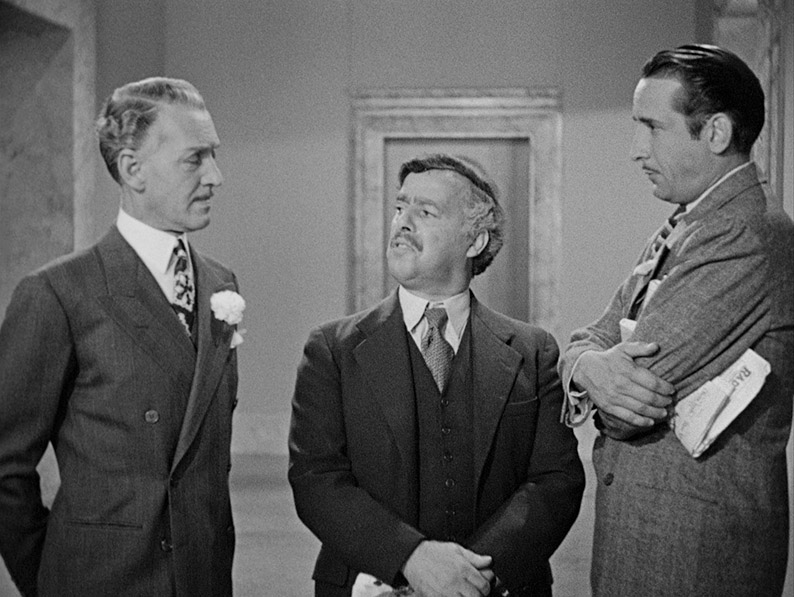
Over-simplified though the situation and storytelling may be, it still entertains and its message hits home, thanks in no small part to some solid performances and breezy direction from the prolific Lew Landers, but also – a tad depressingly – because the essential truth at the film's core is as valid today as it was back in 1943. The practices that so disgust Ulysses about The Gazette are still being employed today in the UK by tabloid rags like The Mail and The Sun,* and while Ulysses' final dictation may have a jingoistic flavour, it still speaks to everything that remains wretched and dishonest about corrupt newspaper editors who use their considerable power to pursue a political agenda and to poison their readership against specific groups and individuals through a process of distortion and fabrication. Consider how relevant these words still are in today's climate of stoked hatred:
"The truly dangerous fifth columnists, the really frightening traitors in our midst, are not men who speak in strange foreign accents and draw their pay from Hitler. No, any man who lets himself get into a group that makes it a business of hating any other group, or race, or creed within this nation, is a fifth columnist."
Listen to the man.
There's a superb bit of cinematic storytelling deception in the opening scene of Shockproof, which was written by Sam Fuller (more on that in a while) and directed by none other than Douglas Sirk. If you want to be as surprised as I was by this sequence then skip the rest of this review (and any others for the film and even plot summaries), as it sets up the story and there's no way to talk about the film without revealing the result of this neatly handled twist.

As the film begins, glamorous brunette Jenny Marsh (Patricia Knight) goes shopping for new clothing on Hollywood Boulevard to make herself look as good for what looks at first like an important job interview, even dyeing her hair blonde for a touch more pizazz. When she arrives at the interview in question, however, it quickly becomes clear that her interviewer, Griff Marat (Cornel Wilde), is in fact Jenny's parole officer, and that she has just been released from prison for killing a man who, we later learn, was threatening the life of her gambler lover Harry Wesson (John Baragrey). After delivering some stern instruction about Jenny's expected conduct and a warning to stay well away from Harry, Griff is a little dismayed when just a few hours later Jenny and Harry are picked up by police during a bookie raid. Yet Griff starts to see some potential in Jenny, and in a move that would likely lose him his job today, he invites her and another parolee to his home for dinner with him and his blind mother (Esther Minciotti). He even gives Jenny a job at his house taking care of his mother (who clearly doesn't need taking care of at all), and quickly finds himself falling for this attractive parolee.
If you think you can see where this is heading then there's a good chance you're right, but the road there is littered with uncertainty and subverted expectations. When Jenny is picked up on the bookie raid, for instance, Griff asks the in-house doctor to check out her twisted ankle in a move that is really a rigged procedure to test Jenny's character, one she passes with flying colours because, unbeknown to Griff, she's streetwise enough to know it was a test from the start. For much of the first half it's nigh-on impossible to be sure what Jenny's feelings towards Griff really are, and almost every time you think she's starting to warm to his affections, she's back with Harry and pleading with him to get her out of there. Griff detests Harry and believes that he is simply exploiting Jenny and that her love for him has made her blind to this fact. Harry, meanwhile, is delighted by the news that Griff is falling for Jenny and encourages her to play along so he can use it to ruin Griff's career and political ambitions. It may sound cut and dried, but in the film's early stages it's surprisingly difficult to be sure just who the good guy is here. Griff may believe that Harry is taking advantage of Jenny, but when a parole officer takes his attractive parolee home for dinner, deliberately misleads her about his marital status, gives her a job at his house to keep her close and then begins romancing her, he's hardly in a position to start pointing fingers.
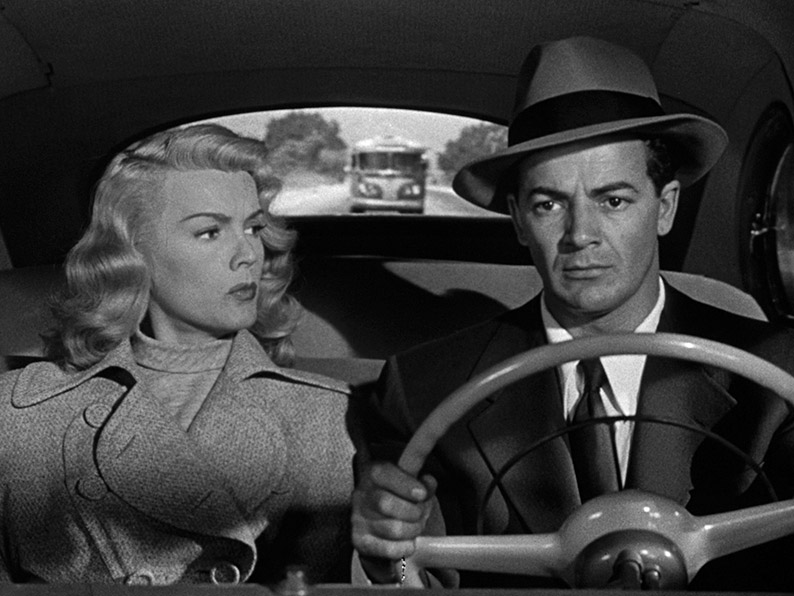
Eventually, inevitably, Jenny really does fall for Griff's honest if slightly predatory affection and kindness, and too late becomes aware of Harry's true colours, which triggers an incident that forces Griff and Jenny to go on the run and the film to confirm its already established noir credentials. Though not as peppered with intrigue as the earlier scenes, this turn of events still fascinates for the transformative effect it has on Griff, as this morally upright champion of the rule of the law makes the decision to cover up one crime and then finds himself forced to commit others to keep on the move, avoid police attention or even provide a meal for himself and his equally desperate companion. What impresses particularly here is that Griff and Jenny really are only ever one step away from being rumbled, as they are forced to abandon a stolen car when the theft is quickly reported, and when a pawn shop owner recognises them he's on the phone to the cops in a matter of seconds. And in a twist that certainly has former reporter Fuller's signature, even when they do find a tucked-away location to hold up, their cover is in danger of being blown by a two-page spread in a tabloid newspaper romanticising their status as criminal lovers on the run.
Sirk and Fuller are clearly on the same page here, with the result that the direction serves the script at every turn to consistently compelling effect. Indeed, even the one real directorial flourish – a match-cut involving Henny's newly purchased hat – is a key component of that opening deception, a cinematically stylish nod to the image he is creating of Jenny as an elegant girl about town.
And then, 85 minutes into a 90-minute film it all goes to pot. Apparently, the studio execs were fine with the script but not happy with Fuller's bold and appropriately dark finale (it's a noir, guys), and brought in National Velvet screenwriter Helen Deutsch to do a rewrite. The result is a painfully preposterous attempt to wring a happy ending from a tale that logically should have concluded (and indeed was originally written to conclude) on a downbeat note. And that's not just me being cynical, as I knew nothing of the rewrite when I first saw the film and caught myself shouting and incredulous "What the hell…?" at the screen as that ending unfolded. In that respect, it's best to go in forewarned, as so much of what comes before is so good that this ridiculous rewrite – one that makes no sense in terms of the characters, their previous behaviour and even the law of the land – should not be the scene you remember the film for.
"Based on the novel The Dark Page by Samuel Fuller" it says in the opening credits. No shit. Of all the films in this collection that weren't directed by Fuller, this is the one that most distinctively bears his stamp. And despite some softening of his characters and plot, Fuller is still very evident in the newsroom setting, the hard-nosed characters and dark twists of the plot, which is well served by director Phil Carlson, who is still primarily remembered for his controversial 1973 crime drama Walking Tall.
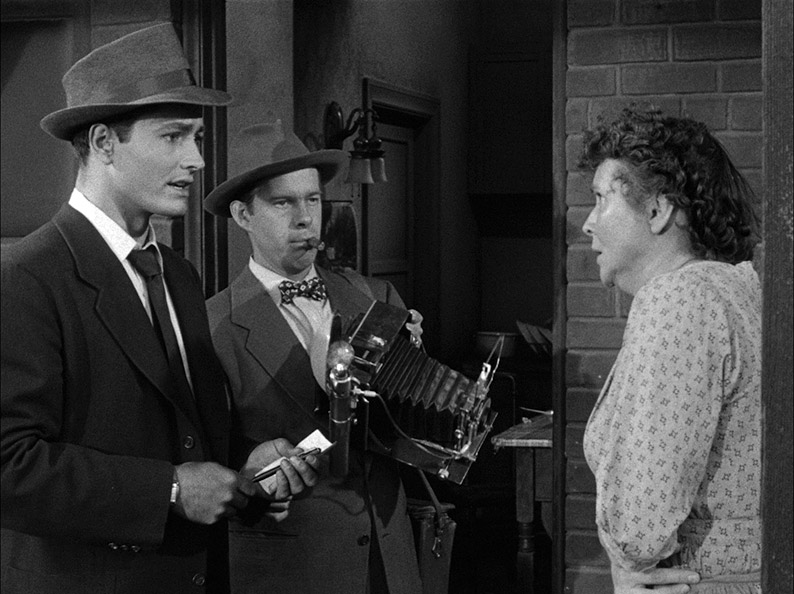
Steve McCleary (John Derek) is a hot young reporter for the New York Express, a once respectable newspaper that now trades in eye-catching headlines and sensationalist stories that its take-no-prisoners editor, Mark Chapman (Broderick Crawford), has no qualms about exploiting or even manufacturing to push the circulation figures high enough to land him the big fat bonus promised in his contract. We're introduced to Steve in the opening scene in a deception almost as neat as the one that opens Shockproof, as he questions the witness to a horrible murder with the manner and dress sense of a police detective, and only after he has the information he needs does he reveal that he's a reporter. He's teamed with equally cynical photographer Biddle (a nicely sardonic Harry Morgan), who on the ride back to the office cheerfully says of the victim, "You know, that wasn't a bad looking dame. Too bad the guy used an axe on her head. Spoiled some pretty pictures for me."
At a stockholder's meeting, there are several complaints about the tawdry direction the paper has taken, but the bullish Chapman argues confidently that while they might not like his approach, it has transformed the paper's fortunes and increased their dividends. He's so confident about the paper's future fortunes and the abilities of his star reporter that he offers part of his expected bonus to Steve so that they can buy up stocks in the paper with the long-term aim of owning it outright.
The conscience of the paper is reporter Julie Anderson (Donna Reed), who has a bit of a thing for Steve, though he seems to be too busy chasing stories to give her the attention she deserves. When she loses a bet that requires her to buy him dinner, for example, he invites Chapman along so that they can talk business while they eat and still expects her to pay. On the way there they are approached by Charlie Barnes, an alcoholic ex-reporter and former Pulitzer Prize winner who's now reduced to begging Chapman for work. Chapman tells him what he wants to hear and sends him on his way, then reveals to Julie, who likes and respect Charlie, that he wouldn't have him in his office let alone on his staff, a cold-hearted viewpoint shared by the ambitious Steve.

That evening, the paper hosts a lonely hearts ball, from which they intend to build the sort of tacky story of the sort that anyone who even glances at British tabloids will be familiar. As the event gets under way, Chapman is recognised and approached by a woman named Charlotte Grant (Rosemary DeCamp) who clearly knows something about him he'd prefer to keep quiet. Back at her apartment we learn that they were once married and that Chapman – which we learn is not his real name – walked out on Charlotte, the impact of which is still visible in the scars on her wrists. The ferocious argument between them that ensues serves to confirm what a heartless bastard he is ("I fell for an attractive hunk of flesh," he contemptuously exclaims), but when Charlotte announces that she intends to expose his identity and potentially damaging details of his past, an angry push sees he bang her head fatally on a metal pipe. Instead of calling the police, Chapman removes all evidence of his presence and any connection between him and Charlotte and moves her body to make it look like she died accidentally due to a fall in the bath. There's just one problem. When the police discover the body, Steve is the reporter who picks up the story, and in no time at all is finding evidence that this apparent accident is not all it seems.
It's a terrific setup that the film (which was adapted from Fuller's novel by the screenwriting trio of Ted Sherdeman, Eugene Ling and James Poe) eagerly runs with, as Chapman's every attempt to cover his tracks falls victim to chance or Steve's dogged determination to get to the root of his story. Particularly effective is the sequence in which Steve brings a photo to Chapman that could incriminate him and suggests they print it to see if anyone recognises the pictured couple (Chapman is younger and angled so that he is not easily identifiable here), and Chapman finds himself caught in a battle between his obvious desire to supress the image and his editor's instinct for a sensational story. He is also very aware that in normal circumstances he would choose the latter in a heartbeat and – crucially – that Steve knows this, and is thus torn between allowing Steve to pursue a path of enquiry that could bring him down and arousing suspicion by preventing him from doing so.
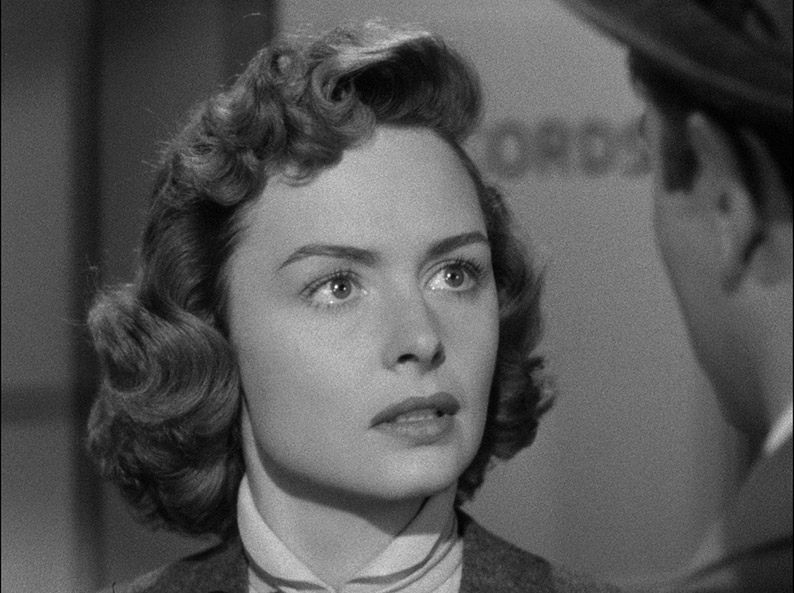
I enjoyed the hell out Scandal Sheet, which moves at a lick, delivers on its twists, boasts some terrific dialogue and maintains is noir credentials right up to the end. I'll confess that I've not read the novel on which it is based and was thus a little saddened to discover that Fuller himself was very dismissive of the film, in part for the changes it made to his characters. Again, it seems that Hollywood was not prepared to fully follow Fuller's lead into the darkness of his own creation.
Now you're talking. If you're watching the films in this set in chronological order, then this is the moment that you'll make the switch from a film written by or based on a novel by Samuel Fuller to a fully-fledge Samuel Fuller film. And the difference is striking. Elements that were pleasing on the previous films feel fully formed here, and there's an attention to character detail and a boldness of content and themes that you just know would be watered down or removed had the material been placed in other, dare I say lesser hands. This is Fuller the writer-producer-director on the sort of form that made him such an inspiration for the next generation of American filmmakers.
It kicks off in the sort of arresting fashion that became a Fuller trademark. In a nightclub in Los Angeles, exotic dancer Sugar Torch (Gloria Pall) puts on a saucy display for both the audience and the camera, and is just approaching her dressing room when a gunshot rings out from within. When she opens the door, a masked man spins round and fires a shot in her direction. She flees from the venue, but falls to her death amidst the night-time traffic on Main Street.

Investigating the crime are Detective Sergeant Charlie Bancroft (Glenn Corbett) and Japanese-American Detective Joe Kojaku (James Shigeta), partners whose close friendship began in the war when a blood transfusion from Joe helped to save Charlie's life. They learn that Sugar was planning a new act involving a crimson kimono and a Japanese karate expert who breaks bricks with his hands. The leads that they follow eventually point them in the direction of the art student who painted the poster for Sugar's new act, an attractive young woman named Christine Downs (Victoria Shaw), to whom Charlie quickly becomes attracted, though his interest in her is far from a one-way street. Charlie has Chris draw up a likeness of their chief suspect, whom she briefly met, but when this is circulated someone responds by taking a shot at her. By this point, Charlie has openly declared his feelings to a responsive Christine, and to protect her from any further attempts on her life, he moves her into the apartment he shares with Joe (I said they were close). But when Charlie is called out one evening by an informant, Chris and Joe get to know each other better and soon realise that they are falling in love.
Even at the surface level, The Crimson Kimono is a fascinating hybrid, a crime thriller that evolves into a love triangle drama, which develops into an examination of racial bigotry and identity in late 1950s American society. And make no mistake, back in 1959 the very idea of portraying and interracial relationship in an American movie was enough to get self-appointed moral guardians in a tizzy. With that in mind, Fuller's presentation of this particularly multicultural district of New York – one known as Little Tokyo – is remarkable for being portrayed as unremarkable. In The Crimson Kimono, much as in real life, this is just how things are, and here white Americans and the Japanese of Little Tokyo interact in such an unforced and naturalistic manner that the issue of race is not an issue at all until Fuller makes it part of the unfolding drama. This extends to having some conversations conducted in Japanese with no subtitle translation (and my Japanese is just good enough to confirm that the dialogue is authentic), but the scenes in question are written and filmed in such a way that you always get the gist of what has been said. Intriguingly, when racial prejudice becomes part of the story, it's not directed at Joe, but grows out of a conflict of identity within Joe himself, as the racism he has witnessed and even experienced over the years prompts him to see bigotry in others where there may well be none.
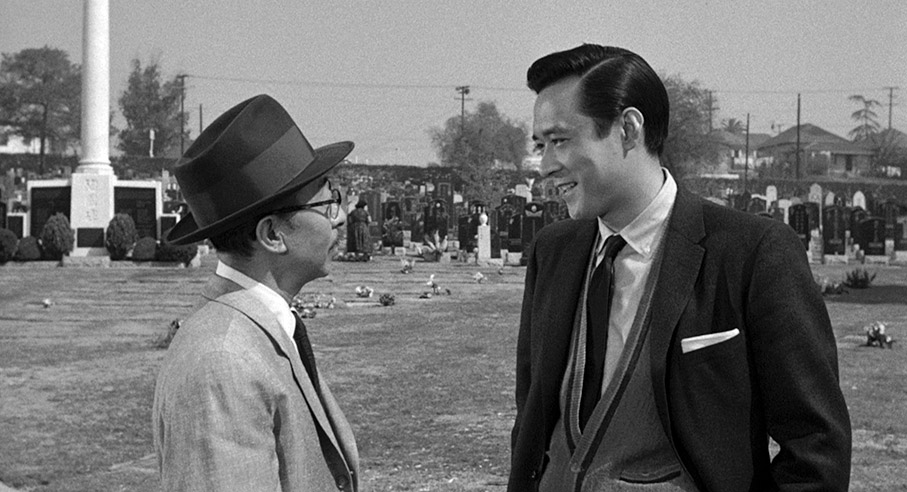
The Japanese community is treated with rare respect here, and intermittently the drama is put on brief hold so that Fuller can highlight aspects of Japanese culture for an audience that would probably have had little experience of it. Thus, we get to watch a prayer ritual in a Buddhist temple, a karate demonstration, and a New Year street festival resplendent with authentically costumed geishas. The camera even lingers at one point on quotes from Dwight D. Eisenhower and General Mark W. Clark on a Nisei war memorial praising the Japanese Americans who fought with the allies in WW2. Yet this never feels like cinematic tourism, with each such diversion connected to the characters or plot development, peaking in an arresting kendo match in which Charlie and Joe are pitted against each other at a crucial moment of emotional crisis.
The film is liberally littered with interesting characters, far and away the most entertaining of whom is Mac (Anna Lee), a delightfully eccentric English painter with a fondness for Charlie and whose alcoholism is portrayed not as a problem but a lifestyle choice to be cheerfully embraced. Her every moment on screen is a near scene-stealer, and she also gets some of the more amusing lines. "Love does much," she says to Charlie with a smile as she falls drunkenly into his arms and takes another swig from a bottle cajoled from him, "but bourbon does everything!"
Fuller's confident and purposeful way with camera movement is also in evidence here, tracking with characters as they walk or drifting slowly around them as they talk to subtly add a touch of dynamism to a potentially static scene. There's nothing here as startling and technically ground-breaking as the celebrated shot in Park Row that follows a character down a street and in and out of buildings, but the one that pulls back with Charlie and Christine as they enter a bar and pans with them as they meet up and sit down with Mac is a lot more complex than its low-key execution makes it seem. And Fuller really shows how to use a facial close-up for emotional effect, and even to deliver and audio-visual jolt when Charlie breaks in the door of an apartment in which his suspect resides and his action smash-cuts to the face of young girl as she screams in fear at this violent intrusion. A tad less classy, but fun nonetheless, comes a few seconds earlier when a screeching cat suddenly leaps (or rather is thrown) into frame as Charlie approaches the door, a nod to the famous Cat People jump-scare perhaps, and a trick that would remain a horror staple right up to its pant-wetting use in Ridley Scott's Alien.
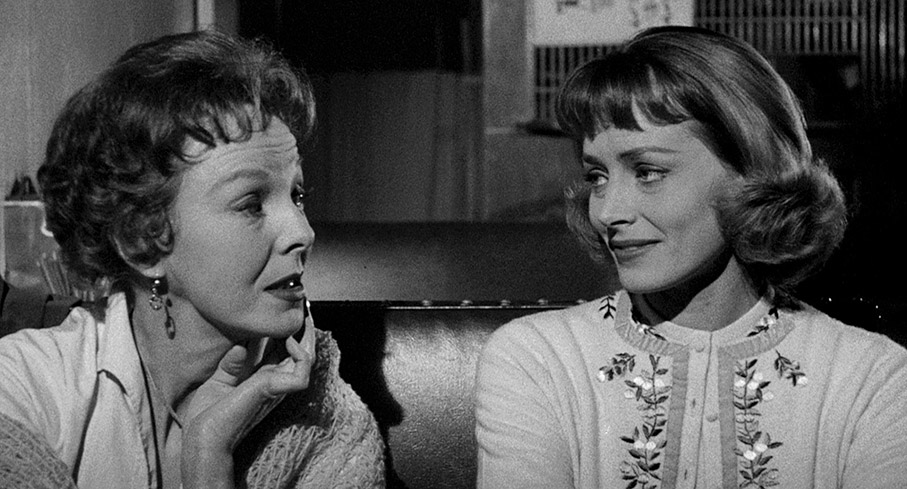
The performances of the three leads are all solid, and there's something rather neat about having a go-getting, all-American lead outmanoeuvred in matters of love by his more sensitive Japanese-American partner. What doesn't become clear (and is then so subtly handled that it's possible not to pick up on it) until late in the proceedings is that the love triangle that so complicates things for the main characters has its equivalent in the lives of those they are pursuing, and is even reflected by the narrative of Sugar's proposed new act, mirror imagery that is also evident in the sequences that bookend the drama. I shall say no more.
If you're looking for reasons why so many of us are so in thrall of the work of Sam Fuller, then The Crimson Kimono is as good a place as any to start. But if you're watching it for the first time in this set, then keep my above stated advice in mind and built up to it via his Fuller's earlier written work and see just what a difference it made to Fuller to have full creative control.
And here is the best reason of all to watch the films in this set in the order in which they were made. Do so and it will climax with this, one of Fuller's absolute best and an example of the American noir crime drama and its uncompromising finest.
It starts arrestingly on a massive close-up of the eyes of 14-year-old Tolly Devlin (David Kent), as he watches a costumed drunk stumble out of a New Year party and collapse in an alleyway, where he proceeds to rob him of his wallet and watch. Soon he's in the backroom of a bar run by the older Sandy, who has effectively become Tolly's surrogate mother after his real mother died in prison, which is where he was born. She has a Christmas present for him, which she retrieves from a wall safe, and once again we're treated to a close-up of Tolly's eyes as he carefully watches Sandy as she dials the combination. The effect is disconcerting. Is Tolly planning to rob this woman that he appears to have such a close bond with? No sir. In one of the many examples of Fuller's storytelling smarts, this visually distinctive moment is designed to filed away for recall far later in the film.
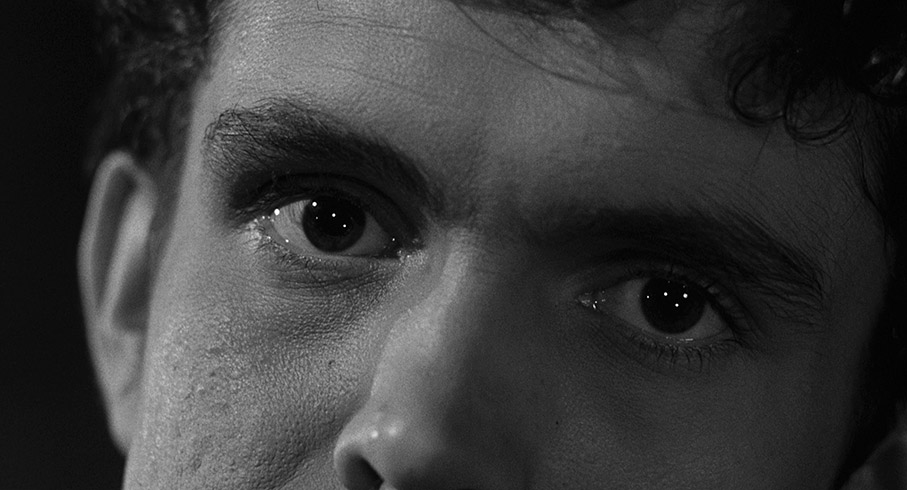
This conversation is disrupted by the sounds of a ruckus in the alleyway out back, and without revealing their presence, they watch on as a group of four men systematically beat a fifth to death, an act of violence that plays out as shadows on a wall, an image so striking it was used for the cover art of Indicator's box set. As the men flee, Tolly recognises one of them as major gangland player Vic Farrar (Peter Brocco), a name Sandy quickly advises him to forget. But they discover that the victim of the assault is Tolly's father, and after refusing to identify Farrar to the police, Tolly makes immediate plans to take revenge on his father's killers.
One night he makes his way to Farrar's house carrying a sizeable metal bar, the sort Scum's Carlin would describe as a "tool." In a particularly neat touch, he at one point drops the bar and then immediately catches it, a single bounce on concrete that would not have been enough to attract attention from nearby houses, but confirms to us what this tool is made of. When he rings Farrar's doorbell, tool at the ready, it's answered instead by his cheerfully drunken wife (it's so typical of Fuller that despite being on screen for only a few seconds, the character is as colourfully defined, confidently performed and memorable as any of the more prominent players), who reveals that Farrar is now in jail where he is serving a life sentence. In his frustration and disappointment, he then attempts to rob a delicatessen for food and ends up banged-up in the state reformatory. If I seem to be giving away a lot, be aware that by this point we're just 10 minutes into a 99-minute movie.
Fuller's skilful way with film grammar then allows him to leap forward in time and clearly indicate the direction that Tolly's life has taken without explanatory captions or title cards, linking the older Tolly (Cliff Robertson) to his 14-year-old self by dissolving the close-up of clenched fist twisting in anguish to a similarly framed shot of the same hand working the combination lock of a safe some years later. This connection is then underlined when his response to the sound of an approaching security guard is captured in a similarly framed close-up of his eyes as the one used to open the film. The scene itself – a series of brief, static and dialogue-free shots in which Tolly is discovered, held at gunpoint, and resigns himself to his fate – is a masterclass in minimalist film storytelling.
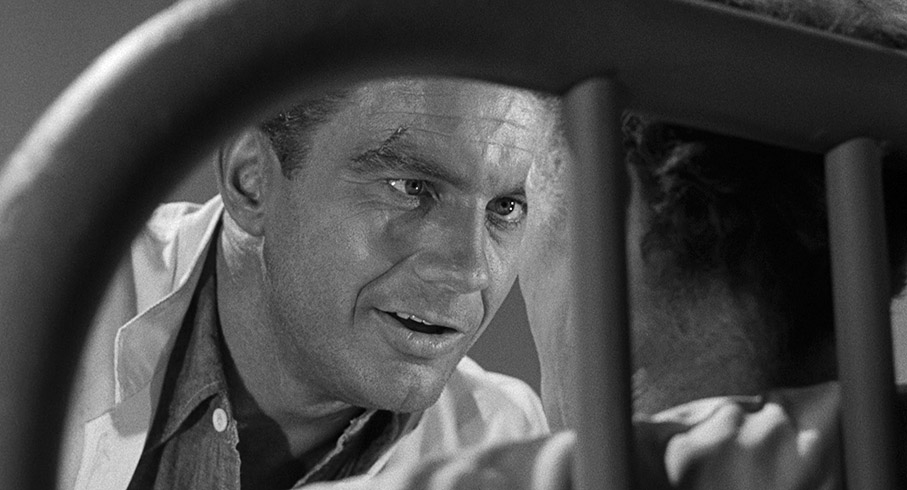
Tolly's latest exploits land him a spell in the clink, and while there he learns from his cellmate that Farrar is not only in the same prison, but is confined to the hospital and fighting for his life. In no time at all, Tolly is hatching a plan to get a job in the prison hospital, his aim being to get access to Farrar and force him to reveal the names of the other three men who murdered his father.
As the story unfolds, it becomes clear that Tolly is the sort of scheming, hard-nosed and relentlessly driven character that in other hands would have been considerably watered down. But as the director and producer of his own screenplay, Fuller's having none of it. We align ourselves with Tolly from an early stage because his suffering is relatable and his cause is righteous, but while the desire to see the killers pay for their crime never abates, Tolly's almost heartless disregard for others and willingness to exploit them in any way he can to achieve his objective makes for a compelling screen character that Fuller never goes out of his way to make likeable. Almost every seemingly noble act is revealed to have an underlying purpose that serves Tolly's unwavering quest for vengeance. This first becomes evident when he rescues a girl named Cuddles (Dolores Dorn) just before she is murdered by Mob enforcer Gus (Richard Rust) because she chickened out of making a heroin delivery. In most crime movies, this would be the moment where the tainted hero saves the girl for whom he will quickly fall, starting him on a path to a redemptive rethink of his life and actions. Here, though, Tolly pretends to be a narcotics detective to press Cuddles to reveal the location of the drugs and then use them to bargain his way into the crime organisation whose three underbosses are the heavily protected men he is seeking. Later, he romances Cuddles (in a scene that has a genuinely erotic flavour) to push her to reveal the name of a women she saw killed by one of his intended targets, and in a sequence that starkly reveals how cold-heartedly cynical he's become, the love-struck Cuddles tells him that she wants to marry him and have his children, to which Tolly blurts out an incredulous "Marry you?" and then breaks down laughing.
Later, the canvas expands to include ruthless Mob boss Earl Connors (Robert Emhardt), investigating District Attorney John Driscoll (Larry Gates), and the activities of Tolly's intended targets, Gela (Paul Dubov), Gunther (Gerald Milton) and Smith (Allan Gruener), who are portrayed less as hardened criminals than high-ranking executives of a wealthy corporation. The metaphor is carried through to Chapman's home base, a rooftop swimming pool to which the street-level operatives have no access and where the bathrobe-swathed Chapman lounges and holds impromptu meetings, and in the boardroom in which he makes plans with his dark-suited executive team. And he really is a scumbag. On learning that the profits from drug sales are down, his calmly tells his underbosses, "There are at least 13 million kids in this country between the ages of 10 and 15. Don't tell me the end of a needle has a conscience. Put more field men to work…around the schools."

When the violence does come it's appropriately brutal, as evidenced in the wincingly sharp gut-punch that leaves its victim crawling across the floor or, in an extraordinary sequence that still shocks today, when the icy-cool Gus – whose signature move is to calmly don sunglasses just before a kill – is ordered by Chapman to send a clear message to an on-the-run bookie who has betrayed the gang by murdering his young daughter.
The ease with which Tolly is prepared to deceive his enemies and theoretical allies alike makes for consistently gripping viewing, as he makes plans and manoeuvres others in a way that sometimes leaves you guessing over the specifics of his long-term goal, while Sandy and Cuddles watch on from the sidelines as the man they both care for becomes increasingly deaf to their pleas. It becomes clear at an early stage that Tolly is on a morally downward trajectory, one that he has little interest in diverging from and that includes no future plans beyond the revenge that becomes his whole reason for living. A glimmer of false hope and a final twist point the way to an appropriately and thrillingly downbeat finale, one that showcases Fuller's eye for brilliantly executed and expressive dolly shots to the max. It's a memorable conclusion to what stands as one of Fuller's finest and most satisfyingly complete works, and the crowning glory of this extraordinary box set.
All seven films in this collection have received high definition remasters from meticulous restorations by Sony and they all look terrific. I was particularly struck by the sharpness and level of detail on It Happened in Hollywood and Adventure in Sahara, largely because of their age and the unshakably low expectations I still tend to have for restorations of older films, a prejudice based on nothing more than years of watching such works in a shocking state of repair on TV and even at independent cinemas and film society screenings. The films not directed by Fuller are all framed 1.33:1, while The Crimson Kimono and Underworld U.S.A. are 1.85:1 and are all, I gather, are in the original projected aspect ratio. Contrast is nicely balanced on all seven films, a tad punchier on The Crimson Kimono and at its nicest on It Happened in Hollywood and Scandal Sheet, which also tend to have the brightest imagery. Black levels are solidly inky throughout the set, which is particularly important for the more noir-leaning sequences in the later films. A fine film grain is evident on all seven transfers, which is a tad coarser on The Crimson Kimono but always feels right for the film in question. Almost all damage has been repaired and all dirt removed, though there is some barely noticeable contrast flickering in places and a couple of more visible visual blips on Power of the Press. An outstanding set of transfers.
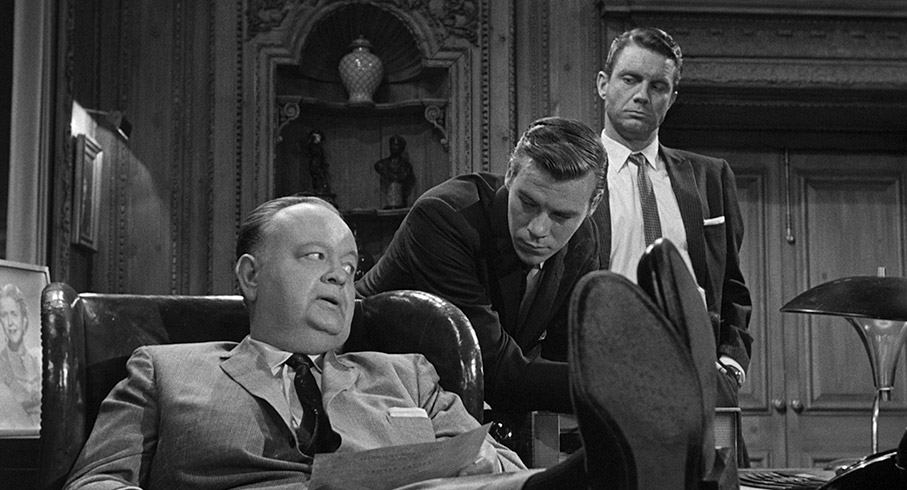
All seven films have Linear PCM 1.0 mono soundtracks and all are in impressive shape for films of their vintage. There is inevitably some narrowing of the dynamic range, particularly on the older films, but the dialogue, effects and music are all clear and even on the older films there is no distortion or abrasive trebles, though some fluff is faintly audible in quieter scenes in It Happened in Hollywood and Adventure in Sahara.
Optional English subtitles for the deaf and hearing impaired are available for all films.
Disc 1
All-Star Party (6:17)
A useful breakdown of the climactic party scene from Adventure in Hollywood, which identifies all the Hollywood personalities being impersonated and who they were played by, including a string of background characters I've never have picked up on and a couple that flit past so quickly you'd probably miss them otherwise.
Sam Fuller's Search for Truth with Tim Robbins (7:10)
Actor and director Tim Robbins recalls first meeting Sam Fuller, with whom he became friends and who he interviewed for Adam Simon's documentary, The Typewriter, the Rifle and the Movie Camera, which features heavily in the extras on discs 3 and 4. He notes that Fuller had compassion for the details of the story and that he used film to open doors to what America is really about. He also remembers Fuller telling him, "One thing I learned early on is everybody's lying; everyone has their own perception, none of it is true."
Image Gallery
34 slides of promotional stills and posters for It Happened in Hollywood, Adventure in Sahara and Power of the Press.
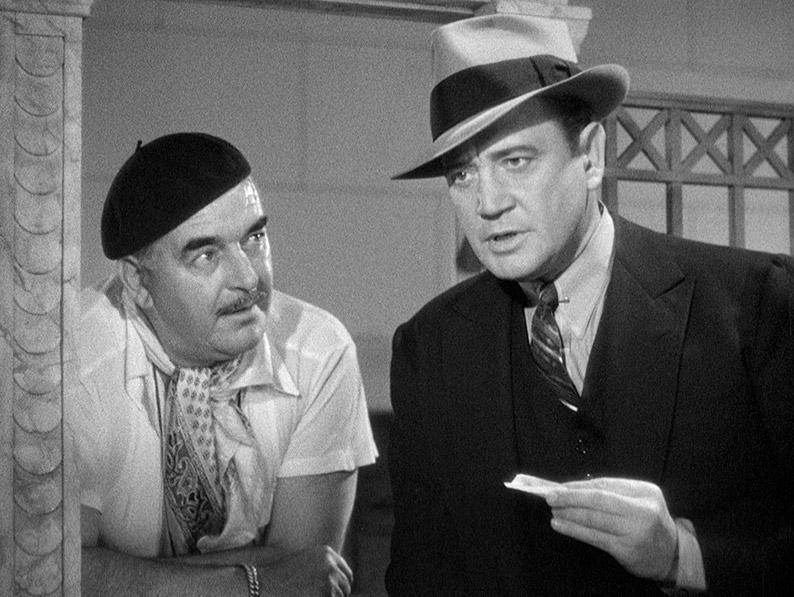
Booklet
Each of the discs has its own booklet, and this one deals with the three films on Disc 1 in chronological order, with credits for the film in question followed by a detailed and newly authored essay by film writer Jeff Billington and examples of the critical response of the day. Billington's writings are of particular interest and include quotes from Fuller, one of which details the originally intended ending of Adventure in Sahara. As you'd expect, there are also spoilers here, so save this (and the others) for after the films.
Disc 2
Scandal Sheet Trailer (2:10)
A pretty good sell, but there are enough spoilers to warrant giving this a miss until after you've watched the film.
Image Gallery
14 slides of promotional stills and a single poster from Shockproof, plus stills and posters for Scandal Sheet and even scans of Fuller's novel, The Dark Page.
Booklet
The booklet here follows the format of its predecessor, with credits for both films on Disc 2, essays on each by Jeff Billington and a sampling of contemporary reviews. Once again, Billington's observations are worth reading and are peppered with Fuller quotes, but we are also treated here to an extract from Fuller's novel The Dark Page, on which Scandal Sheet was based.
Disc 3
The Culture of the Crimson Kimono (9:35)
An interview with L.A. Confidential director and confirmed Fuller fan Curtis Hanson, who sets the tone at the start by saying, "Crimson Kimono fits into no genre other than the Sam Fuller genre, which I would say about, I think, every one of his pictures. They are unique to him." This is one of those times when a special feature effectively undercuts my review by picking up on many of the very same points, but it took Hansen to wake me up to the idea that this is more a love story between the two detectives than it is between Christine and either of the men.
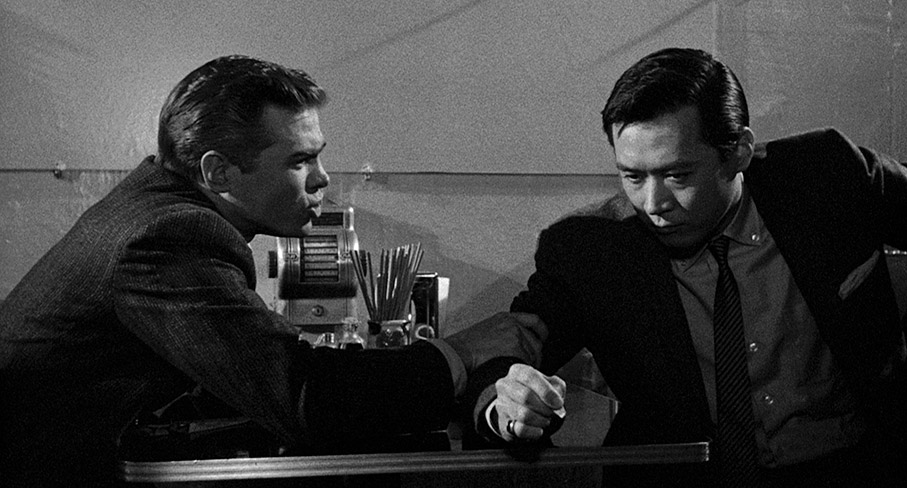
Switch-Hitting Between Three Triangles (14:50)
A video essay by Cristina Álvarez López that explores the film's three love triangles, how they interconnect, how the film switches between them and how they all contribute to the thematic development and narrative resolution of the film. There's little here that shouldn't be self-evident to attentive viewers, but it's well argued and clearly presented and makes a good case for the complexity and sophistication of the film's thematic sub-structure.
Sam Fuller Storyteller (24:26)
An appreciation of Sam Fuller and his films built around interviews with filmmakers Curtis Hanson, Wim Wenders, Martin Scorsese and Tim Robbins, Fuller's widow Crista and his daughter Samantha. Topics covered include Fuller's early life, his wartime experiences (he despised war but loved soldiers, we are informed), his filmic style, his hatred of having to shoot a second take, his skill as a verbal storyteller (Wenders describes him as "the greatest storyteller I ever met in my life"), and more. Crista praises Scandal Sheet but still urges us to read the book to get an idea of what it could have been had Sam directed it, Wenders recalls how his first meeting with Fuller and how it transformed the fortunes of Alice in the Cities, and Curtis Hanson recalls the times where he'd pass the room in which Sam was writing and drop in on him and be enthusiastically regaled with details of the story under construction. Great stuff.
Sam Fuller on Henry Chapier's Couch (21:45)
An episode from the French TV series Le Divan, in which film critic Henry Chapier interviews Fuller on what looks like the most luxurious psychiatrist's couch in existence. Much of what Fuller says here is covered in more detail in the rushes from The Typewriter, The Rifle and the Movie Camera (see below), but there are still a couple of stories unique to this extra, and Fuller amusingly demolishes an attempt to Rorschach test him ("It looks like a bat or a drunken Christmas tree! That's the same tree turned upside down!").
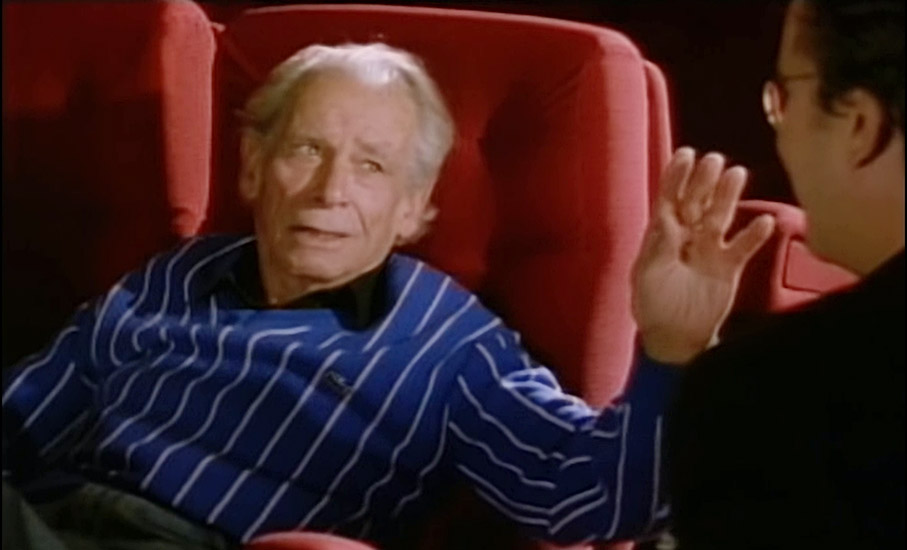
‘The Typewriter, the Rifle & the Movie Camera' Rushes Tapes 01-06 (3:13:42)
In 1996, director Adam Simon teamed up with actor and filmmaker Tim Robbins to deliver a riveting documentary portrait of Samuel Fuller titled The Typewriter, the Rifle and the Movie Camera, which included contributions from Jim Jarmusch, Martin Scorsese and Quentin Tarantino, plus extensive interviews with Fuller himself shot in his adopted city of Paris. Now when it comes to documentary interview footage, you tend to shoot considerably more than you end up using in the final cut, cherry-picking the best and most relevant material and discarding the rest. Such could easily have been the fate for the footage of Fuller shot for this documentary – the 16mm film originals certainly appear to have been lost, but the diligent and determined people at Indicator have nonetheless unearthed SD tape transfers of the same, and in a move that may sound daunting but which you will later find yourself singing their praises for, they have decided to include all of the unedited footage (or rushes) of Fuller on the third and fourth Blu-ray discs in the collection. That's six-and-three-quarter hours of raw material, primarily of Fuller being interviewed by Robbins. And it's pure gold. At 84 years of age (he unfortunately died the following year), Fuller is a hugely entertaining and ferociously expressive interviewee, running with stories and dismissing any attempts at interruption, suddenly barking out lines at a volume that must have given the sound operator a headache and laughing raucously at certain memories and proclamations. To start listing all of topics covered by Fuller here would take an age, but the first six tapes, most of which run for just over half-an-hour apiece, include stories about his early days (including how to win a fight by punching your opponent in the solar plexus – don't try this at home, kids), his life-changing first visit to a newspaper print house, meeting legendary newspaper editor Arthur Brisbane, his first byline and his first written piece for Hollywood, his admiration for Balzac and Rodin's The Thinker, the things he learned as a journalist, why socialism is the future of mankind and so much more. Repeatedly the film runs out whilst Fuller is in full flow (film magazines tended to run for about ten minutes before having to be changed or reloaded), but in seemingly every case the conversation has been allowed to play out in its entirety without the picture, a decision I heartily applaud as there are some real gems nestled away between the magazine changes.
Theatrical Trailers (1:02 / 0:22 / 1:51)
Three trailers here. The first has narration, the second is a shorter version of the first, and the third is an extended take where the narration has been replaced by captions. All skip through the first half of the story to focus on the race angle and what the love triangle does to Joe and Charlie's friendship, and depressingly asks of Joe, "What is his strange fascination for American girls?" which is just the sort of racism that Fuller and his film makes such a strong stance against.
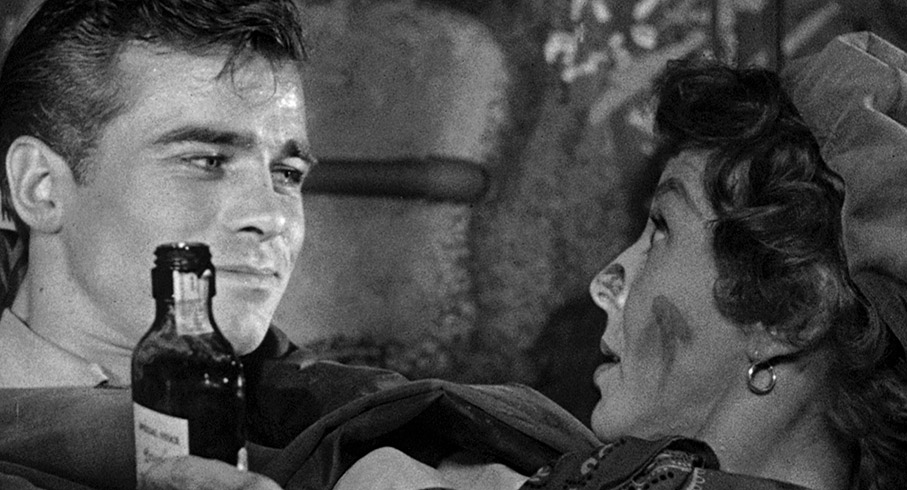
Image Gallery
19 slides of promotional stills and posters for The Crimson Kimono.
Booklet
Here the film credits are followed by a detailed and thoughtful essay on The Crimson Kimono by critic and film historian Pamela Hutchinson. Up next is a sizeable collection of extracts from Fuller's autobiography, A Third Face: My Tale of Writing, Fighting, and Filmmaking, in which he talks about the making of the film. Finally, we have three contemporary critical responses to the film. As with the other booklets, this one is illustrated with stills and promotional artwork.
Disc 4
Martin Scorsese on ‘Underworld U.S.A.' (5:11)
Scorsese kicks off neatly by stating that Fuller "made a film as good as he talked it" and highlights the specifics of Underworld U.S.A. that have stayed with him and influenced his own work, summing up its style by saying, "Almost every shot hits you like a punch."
Barry Forshaw on ‘Underworld U.S.A.' (9:35)
Film historian and journalist Barry Forshaw provides a concise appreciation of the film, describing Fuller as "an authentic American primitive" and the film itself as "a clenched fist movie." He talks about the film's style and its anti-hero lead, and provides info on Cliff Robertson and a couple of the supporting players.
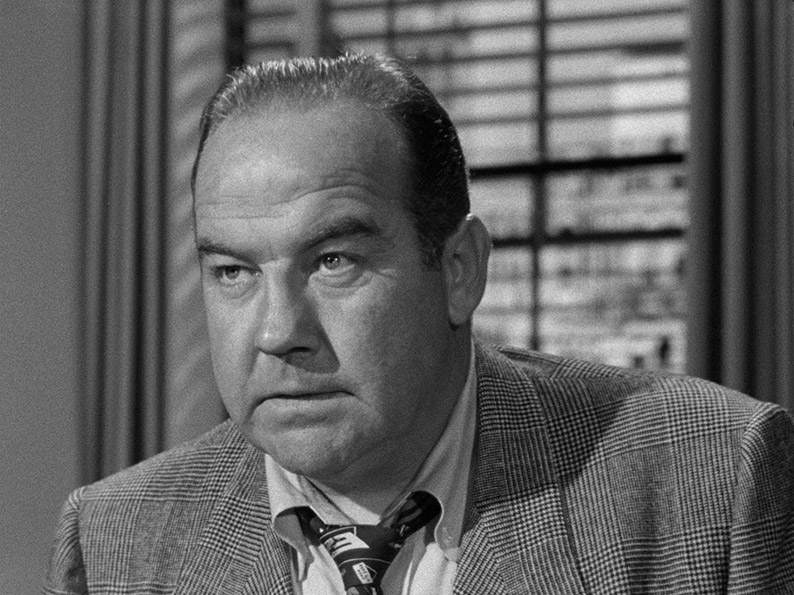
Sam Fuller Masterclass with Wim Wenders (62:09)
Recorded at the Arri Cinema during Filmschoolfest Munich on 26 November 1993, this on-stage discussion before an audience of film students has Wenders prodding Fuller for stories and opinions and just occasionally adding his own views and memories, and even disagreeing with Fuller on a point about film funding. It's an audio-only piece that runs under the first two-thirds of the film (a decision those of us with screens that suffer burn-in heartily salute), and pleasingly has little crossover with the other special features in this set. Fuller talks about the importance of having a hook to a story, why a film should show an action rather than have characters talk about it, his admiration for the writings of Dostoyevsky, the directing style of Alfred Hitchcock and the ending of Margaret Mitchell's Gone with the Wind, the advantages of making films for a big studio and pitching them to a film-loving mogul like Daryl Zanuck, and more. He gives a great example of how to invest a scene with emotion, and suggests that if America chose to make one less nuclear weapon, the money saved could allow every film school in the country to make their own feature.
‘The Typewriter, the Rifle & the Movie Camera' Rushes Tapes 07-12 (3:30:50)
The last six tapes of rushes are every bit as entertaining and educational as the first and again cover a huge amount of ground, thanks in part to Fuller's penchant for leaping off at interesting but sometimes diverse tangents when telling a story. Areas covered here include: the first time he killed an enemy soldier in the war; his first impression of Hollywood; pitching stories to his favourite movie mogul Daryl F. Zanuck; the McCarthy era and his deep admiration for blacklisted screenwriter Dalton Trumbo; pitching and casting The Crimson Kimono; setting up and casting roles in Run of the Arrow; some aspects of his films that his mother hated; the reaction of some of his former comrades to The Big Red One and so much more. By including all the footage, we also get to see how the film's faux-chance meeting between Fuller and Robbins on a street in Paris was staged over the course of multiple takes, the first of which is effectively directed by Fuller himself. Particularly revealing is the final tape, where Robbins shouts out words or names or film titles and Fuller barks back a short response in what plays like a biographical word association test, with some answers poetically linked to the ones that directly follow. Thus, we get: "Fascist" – "Enemy of mankind" / "Communist" – "Enemy of mankind" / "Democrat" – "Mankind" (intriguingly, Fuller's antipathy towards Russian communists stems from the fact that they followed Stalin instead of Alexander Kerenski and Karl Marx, both of whom he clearly admired); and "Heroes" – "Don't believe in them" / "Cowards" – "Don't believe in them" / "Religion" – "Don't believe it!" Fuller's hatred for fascists, meanwhile, is vividly illustrated when Robbins tries him with, "Neo-Nazis today," and Fuller responds without a pause, "Should be eliminated instantly." Marvellous stuff from start to finish.

Theatrical Trailer (2:25)
Introduced by none other than Fuller himself, it's a brisk and incident-busy promo for the film that spoilers that will only probably count as spoilers if you watch this just before the film itself.
Image Gallery
21 slides of stills, and posters for Underworld U.S.A., which also reveals a couple of the film's international titles.
Booklet
The final booklet follows the pattern set by its predecessors by opening with full credits for the film and an in-depth essay on it by author Dr Lindsay Anne Hallam, who is also a Senior Lecturer in Film at the University of East London. Up next are some typically enthralling quotes from Sam Fuller on the making of Underworld U.S.A., and a revealing piece detailing the problems the film faced due to the then still constricting Production Code. Rounding things off once again are examples of the critical response of the day to the film.
Back in my film school days, I spent a disproportionate amount of my free time during the holidays attending seasons of films run by the BFI at what was then known as the National Film Theatre (it's now the BFI Southbank), and these often included lesser-known works by filmmakers or ones in which their input was less pronounced or distinctive than it would later become. Watching the films in this set was a little like taking a trip back to those days, as it offers us the chance to see Fuller's voice become more pronounced as his career progressed, peaking in electrifying fashion when he finally took full control of his own projects. This really is an extraordinary box set, for the films themselves, for the consistently high quality of the restorations, and for a package of extra features whose quantity and quality currently have no peer. If you have a full-time job and intend to watch all the films and special features in this glorious collection, then I'd set aside a week or two and politely inform any non-cineaste friends and family members that you have important work on your plate and that you'll catch up with them later. If you're already a fan of the cinema of Samuel Fuller then consider this an essential purchase if you don't already have it, and if you're somehow new to his work, then know that this is the far and away best and most comprehensive box set devoted to this singular filmmaker that I've yet encountered. Frankly, I'd be recommending it highly for the rushes from The Typewriter, the Rifle & the Movie Camera alone, but you also get two of Fuller's finest films as a director, five more of increasing quality (well, if you switch the first two around) that were based on his writings, and a solid collection of other supporting extras, including 4 handsomely produced and well-written booklets. Which to my mind makes this a strong candidate for Blu-ray release of the year so far. Unreservedly and enthusiastically recommended.
|